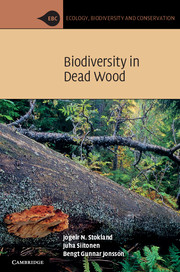Book contents
- Frontmatter
- Contents
- Preface
- 1 Introduction
- 2 Wood decomposition
- 3 The saproxylic food web
- 4 Other associations with dead woody material
- 5 Host-tree associations
- 6 Mortality factors and decay succession
- 7 Microhabitats
- 8 Tree size
- 9 The surrounding environment
- 10 Evolution of saproxylic organisms
- 11 Species diversity of saproxylic organisms
- 12 Natural forest dynamics
- 13 Dead wood and sustainable forest management
- 14 Population dynamics and evolutionary strategies
- 15 Threatened saproxylic species
- 16 Dead wood in agricultural and urban habitats
- 17 The value and future of saproxylic diversity
- References
- Index
15 - Threatened saproxylic species
Published online by Cambridge University Press: 05 June 2012
- Frontmatter
- Contents
- Preface
- 1 Introduction
- 2 Wood decomposition
- 3 The saproxylic food web
- 4 Other associations with dead woody material
- 5 Host-tree associations
- 6 Mortality factors and decay succession
- 7 Microhabitats
- 8 Tree size
- 9 The surrounding environment
- 10 Evolution of saproxylic organisms
- 11 Species diversity of saproxylic organisms
- 12 Natural forest dynamics
- 13 Dead wood and sustainable forest management
- 14 Population dynamics and evolutionary strategies
- 15 Threatened saproxylic species
- 16 Dead wood in agricultural and urban habitats
- 17 The value and future of saproxylic diversity
- References
- Index
Summary
Saproxylic species are one of the most threatened organism groups. As with all forest species, they are suffering from the dwindling of forests. But the habitats of saproxylic species may also be decreasing in regions where, although the forest area is currently increasing, such as in Europe, practically all forests and other wooded areas have been taken into intensive economic use, resulting in a greatly reduced abundance of large over-mature trees and large-diameter dead wood (see Chapters 13 and 16). As a consequence, many saproxylic species dependent on these habitat structures have drastically declined and have become threatened.
In this chapter we examine threatened saproxylic species, their threat factors and the assessment of their threat status. The historical development which has led to so many saproxylic species becoming threatened is best known in Europe, and hence we first give a short account of the endangerment history of saproxylic species based on European examples. Next we list the current threat factors which reduce the number and extent of habitats for wood-inhabiting species. We also discuss the knowledge base, methods and criteria used in assessing the threat status of species. Knowledge on threatened species needs to be improved, and in the final section we examine survey methods. We have described, in other chapters, general measures that can be taken to maintain the overall diversity of saproxylic species in managed forests (Chapter 13) and in cultural habitats (Chapter 16). Most of these methods benefit threatened saproxylic species too.
- Type
- Chapter
- Information
- Biodiversity in Dead Wood , pp. 356 - 379Publisher: Cambridge University PressPrint publication year: 2012
- 6
- Cited by



